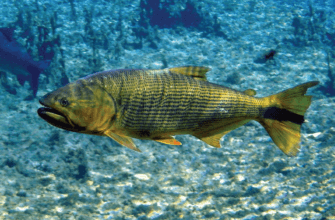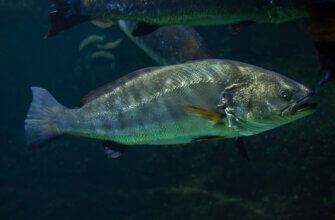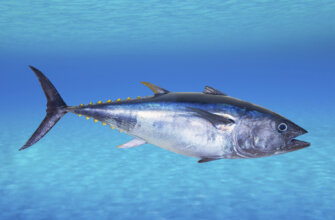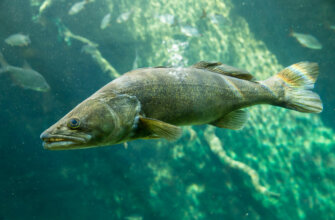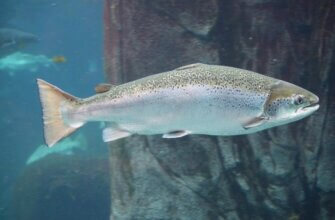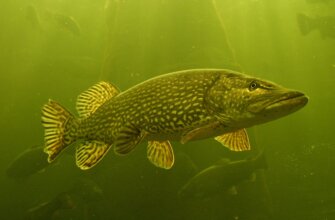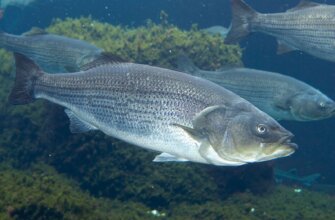Perch is a common name for several different species of fish in the family Percidae, which is a family of freshwater fish found in North America and Europe. Some examples of Perch species include the Yellow Perch, European Perch, and Walleye.
Perch are generally small to medium-sized fish, typically measuring between 15-30 cm in length, although some species can grow larger. They have a distinctive shape, with a round body and a spiny dorsal fin.

Perch are popular game fish and are commonly sought after by recreational fishermen. They are known for their firm, white flesh and mild flavor, and are often cooked by pan-frying or baking. Perch are also important in commercial fishing, and are farmed in some areas for food production.
In addition to being valued for their meat, Perch are also important in aquatic ecosystems as predators and prey. They play a vital role in maintaining the health and balance of freshwater ecosystems.
Species
There are several species of perch found around the world.
Here are some notable examples:
- European Perch (Perca fluviatilis). The European Perch is one of the most well-known perch species. It is native to Europe and has been introduced to various other regions. It typically has a greenish-bronze body with dark vertical stripes. European Perch are popular game fish in Europe.
- Yellow Perch (Perca flavescens). Yellow Perch are native to North America, particularly in the Great Lakes region and surrounding areas. They have a yellowish-green body with dark vertical stripes and are known for their flavorful meat. Yellow Perch are highly sought after by anglers.
- Walleye (Sander vitreus). Although commonly referred to as a perch, the Walleye is actually a species of freshwater fish in the perch family. It is native to North America and is known for its excellent taste and large size. Walleye have distinctive eyes that appear reflective, hence their name.
- Balkhash Perch (Perca schrenkii). The Balkhash Perch is found in the Balkhash Lake in Kazakhstan and China. It has a silvery body with dark markings. This species is of economic importance in the region as a food fish.
- Nile Perch (Lates niloticus). The Nile Perch is a large freshwater fish found in Africa, particularly in Lake Victoria and the Nile River. It is not a true perch but is often referred to as one. Nile Perch are prized by sport anglers for their size and strength.
These are just a few examples of the many perch species found worldwide. Each species has its own distinct characteristics and distribution range.
Appearance
Perch have a distinctive appearance that is shared by various species within the Percidae family.
Here are some general characteristics of perch:
- Body Shape: Perch have a somewhat elongated and rounded body shape. They typically have a deep and compressed body, which means they are tall from top to bottom rather than being wide from side to side.
- Size: Perch species vary in size, but most fall within the range of small to medium-sized fish. Depending on the species, they can measure anywhere from a few inches to a foot or more in length.
- Coloration: The coloration of perch can vary depending on the species and their environment. They often have a combination of green, brown, or yellowish hues on their back and sides. Many perch species have vertical dark bands or stripes running down their sides, which help to camouflage them in their habitat.
- Fins: Perch have several fins, including the dorsal fin, which is usually spiny and located along the back. The number of spines in the dorsal fin can vary between species. They also have pectoral fins, pelvic fins, and an anal fin. The shape and size of these fins can differ slightly among different perch species.
- Mouth: Perch have a relatively large mouth with a slightly underslung or forward-facing position. Their mouth is equipped with sharp teeth, which they use to capture and eat prey.
- Eyes: The eyes of perch are usually round and positioned on the sides of their head. This helps them have a wide field of vision, which is beneficial for hunting and avoiding predators.
It’s important to note that specific species of perch may have unique characteristics or color variations that distinguish them from one another. The details mentioned above are general features that are commonly associated with perch but may vary among different species.
Size and weight
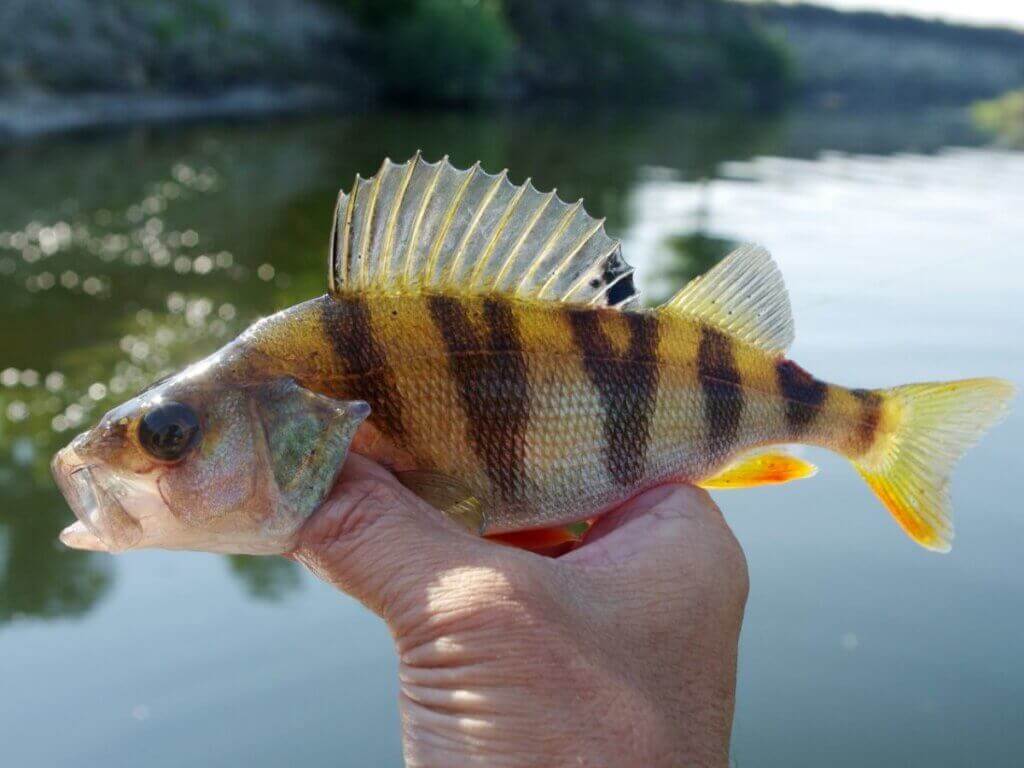
Perch are typically small to medium-sized fish. The average size of a perch is around 4 to 10 inches (10 to 25 centimeters) in length. However, some larger species of perch can reach lengths of up to 20 inches (50 centimeters) or more.
In terms of weight, again, it depends on the species and individual fish. On average, perch usually weigh between 4 ounces (113 grams) and 1 pound (454 grams). Larger species can weigh up to 2 to 3 pounds (0.9 to 1.4 kilograms) or more.
It’s important to note that these size and weight ranges are approximate and can vary depending on the specific species, habitat, and other factors.
Diet
Perch are carnivorous fish, which means they primarily feed on other smaller aquatic organisms. Their diet consists mainly of small fish, insects, crustaceans, and various aquatic invertebrates.
Here are some common food sources for perch:
- Small Fish – perch feed on smaller fish such as minnows, shad, and young sunfish. They are opportunistic predators and will prey on any small fish that they can capture.
- Insects and Invertebrates – perch have a diverse diet that includes insects and other invertebrates. They will consume aquatic insects like mayflies, caddisflies, and beetles. They also feed on crustaceans such as crayfish and shrimp.
- Zooplankton – in certain cases, especially when they are young, perch may consume zooplankton, which are tiny aquatic organisms drifting in the water column.
Perch are known for their predatory behavior and will actively hunt for their prey. They use their sharp teeth and agile bodies to capture and consume their food. They typically feed during daylight hours, especially during dawn and dusk when their prey is most active.
It’s worth noting that the specific diet of perch can vary depending on their habitat, availability of food sources, and seasonal changes.
Behavior
Perch exhibit various behaviors that are characteristic of their species.
Here are some common behaviors observed in perch:
- Schooling. Perch are known to form schools or shoals, especially during their juvenile stages. This behavior offers them protection against predators and enhances their feeding efficiency.
- Ambush Predation. Perch are ambush predators, meaning they lie in wait for their prey and strike with a sudden burst of speed. They often position themselves near structures such as submerged vegetation, rocks, or fallen trees, using these features as cover to surprise their prey.
- Feeding Patterns. Perch are opportunistic feeders and exhibit diurnal feeding patterns. They are most active during daylight hours, particularly during dawn and dusk. During these times, they actively search for prey, patrol their territory, and engage in feeding frenzies.
- Territoriality. Perch are known to establish and defend their territories. They may aggressively defend their preferred feeding areas, spawning grounds, or sheltered hiding spots from other perch and intruders.
- Spawning Behavior. During the breeding season, which typically occurs in spring or early summer, male perch establish territories and build nests. They court females and engage in elaborate mating displays. After spawning, the males guard the eggs until they hatch.
- Seasonal Movement. Perch can exhibit seasonal movement patterns in response to changing environmental conditions. In colder months, they may move to deeper waters where the temperature is relatively stable. As water temperatures rise in spring, they may move to shallower areas for feeding and spawning.
- Solitary Behavior. While perch often school together, they can also exhibit solitary behavior, especially larger individuals. These solitary perch may occupy specific areas and become more territorial.
It’s important to note that the behavior of perch can vary depending on factors such as habitat, population density, food availability, and individual characteristics.
Spawning
Spawning in perch, also known as perching or breeding, is an important reproductive behavior that occurs during specific seasons, typically in spring or early summer when water temperatures rise.
Here’s an overview of the spawning behavior in perch:
- Nest Building: Male perch are responsible for preparing spawning sites and building nests. They select suitable areas near the shoreline, typically in shallow waters with vegetation or submerged structures like rocks, logs, or aquatic plants. Using their tails, males create small depressions or pits on the lake or riverbed to serve as nests.
- Courtship and Mating: Once the nests are prepared, male perch attract females through courtship displays. This includes changing colors, vibrating movements, and chasing behavior. The male tries to entice a female to enter his nest.
- Egg Laying: After successful courtship, the female enters the nest and releases her eggs, which are adhesive and stick to the vegetation or substrate. A male immediately follows the female and fertilizes the eggs by releasing his milt (sperm) over the eggs.
- Nest Guarding: After spawning, the male perch takes on the responsibility of guarding the nest and the fertilized eggs. The male remains close to the nest, aggressively defending it from intruders and ensuring the survival of the developing eggs.
- Incubation and Hatching: The eggs typically hatch within 1 to 2 weeks, depending on water temperature. The male continues to protect the nest during this period, fanning the eggs with his fins to ensure proper oxygenation and water flow. Once the eggs hatch, the male may stay with the fry (baby perch) for a short period before they disperse.
It’s important to note that spawning behavior can vary depending on the specific species of perch and the local environmental conditions. Factors such as water temperature, water quality, and photoperiod (day length) play a significant role in triggering and synchronizing the spawning process among perch populations.
Fishing
Perch are a popular game fish, and many anglers enjoy targeting them.
Here are some tips for fishing perch:
- Location. Look for areas where perch are likely to be found, such as near structure or cover in the water, such as weed beds, submerged logs, or rocks. Perch are often found in shallow waters, particularly during spring and fall.
- Bait. Perch are opportunistic feeders and will eat a variety of baits. Live baits such as minnows, worms, and grubs work well, as do artificial baits like jigs, spinners, and crankbaits. Experiment with different colors and sizes to see what works best in your fishing location.
- Tackle. Light tackle is ideal for catching perch. A spinning rod and reel combo with 4-8 lb test line is sufficient for most perch fishing situations. Use a light weight that is just heavy enough to cast and to keep the bait near the bottom.
- Presentation. Perch tend to feed near the bottom, so it’s important to keep your bait close to the bottom. A slow, steady retrieve with occasional pauses and twitches can be effective. Use a slip bobber to keep your bait at the right depth and to detect bites.
- Time of Day. Perch are most active during daylight hours, particularly during dawn and dusk. Fishing during these times can increase your chances of catching them.
- Catch and Release. If you plan on releasing the perch you catch, handle them gently and quickly to minimize stress. Use a landing net to avoid injuring the fish, and remove the hook carefully.
It’s important to note that fishing regulations can vary depending on your location and the species of perch. Be sure to check local regulations and obtain the appropriate fishing licenses before you go fishing.
Lures
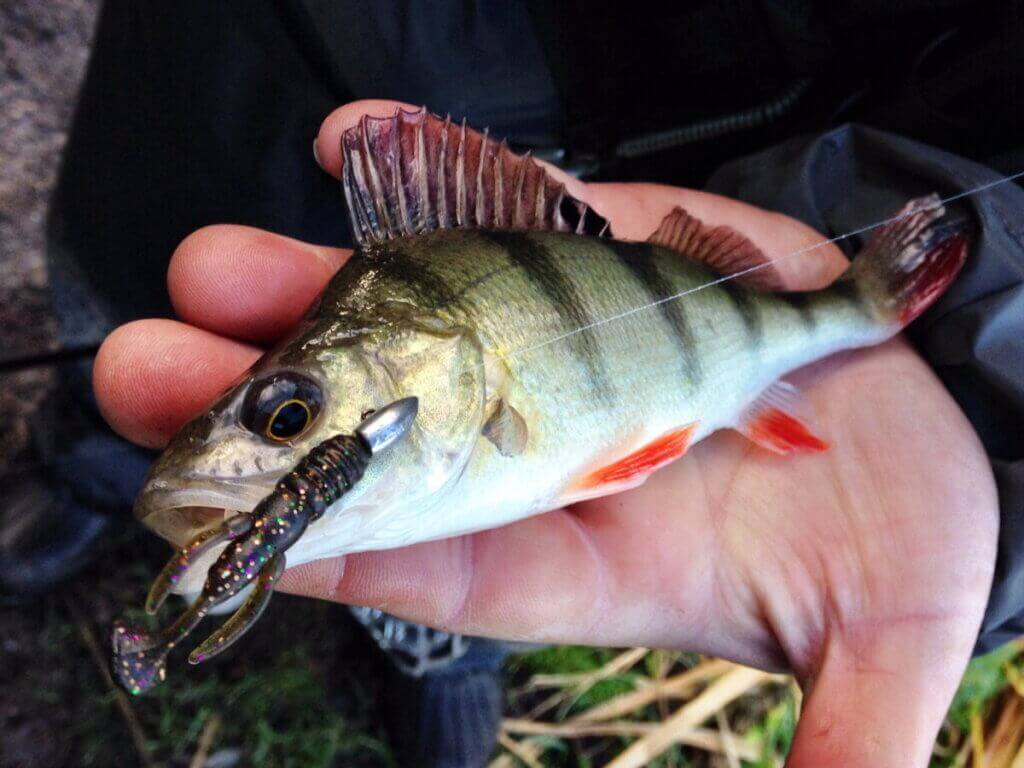
When it comes to lures for perch fishing, there are various options that can be effective in attracting and catching perch.
Here are some popular lure choices:
- Jigs: Jigs are versatile lures that work well for perch. Use small jigs in sizes ranging from 1/16 to 1/4 ounce, depending on the depth and current conditions. Choose jigs with colorful bodies and add a small soft plastic or live bait (like a worm or minnow) for added attraction. Jigging the lure near the bottom or around structures can entice perch to strike.
- Spinners: Spinners are effective lures for covering water and attracting perch. Choose small-sized spinners with silver, gold, or colorful blades. The flash and vibration produced by the spinner can trigger the predatory instincts of perch. Retrieve the spinner at a moderate speed to mimic a small fish or baitfish.
- Crankbaits: Small crankbaits that imitate small baitfish can be productive for perch. Opt for shallow-diving or lipless crankbaits in natural colors or patterns. Retrieve the crankbait at a steady pace, and vary your retrieval speed to see what entices the perch to bite.
- Soft Plastics: Soft plastic lures like grubs, worms, and small swimbaits can be effective for perch. Use small-sized soft plastics in natural colors or bright hues. Rig them on a jig head or use a drop shot rig to present the lure near the bottom where perch often feed.
- Flies: Fly fishing for perch can be enjoyable and productive. Use small-sized flies such as streamers, woolly buggers, nymphs, or small poppers. Match the color and size of the fly to the natural prey in the water. Retrieve the fly with short, jerky movements or a slow strip retrieve.
Remember to experiment with different lures, colors, and retrieval techniques to determine what works best in your fishing location and under the current conditions. Pay attention to the preferences of the perch on that particular day, as their feeding patterns can vary.
Here are some examples of fishing lures for perch with specific models and specifications:
- Jig: Northland Tackle Fire-Ball Jig.
- Model: Fire-Ball Jig.
- Weight: 1/16 to 1/4 ounce.
- Color: Assorted colors available.
- Features: Short-shank hook with a wide gap, holographic or painted finish for added attraction, single or double hook configuration.
- Spinner: Mepps Aglia Spinner.
- Model: Aglia Spinner.
- Size: #1 to #3.
- Color: Silver blade with various colored bodies (e.g., silver, gold, chartreuse, white).
- Features: Classic French blade design, stainless steel shaft and blade, vibrant colors for visibility, available in dressed or plain configurations.
- Crankbait: Rapala Ultra Light Crank.
- Model: Ultra Light Crank.
- Size: 1 1/2 inches.
- Color: Natural or vibrant colors (e.g., silver, gold, firetiger).
- Features: Floating design, realistic swimming action, internal rattles for added sound attraction, diving depth of around 4-6 feet.
- Soft Plastic: Berkley PowerBait Power Grub.
- Model: Power Grub.
- Size: 2 inches.
- Color: Assorted colors available (e.g., chartreuse, white, black).
- Features: Ribbed body for added vibration, PowerBait scent for attracting fish, can be rigged on a jig head or used on a drop shot rig.
- Fly: Woolly Bugger Fly.
- Model: Woolly Bugger.
- Size: #8 to #12.
- Color: Olive, black, or brown.
- Features: Marabou tail and hackle, weighted or unweighted, versatile pattern that imitates various aquatic prey, can be retrieved with various techniques (strip, twitch, slow retrieve).
These are just a few examples, and there are many other lures available on the market. Remember to choose lures that match the conditions you’re fishing in, such as water clarity, depth, and the behavior of the perch. It’s also helpful to have a variety of sizes and colors to adapt to changing conditions and the preferences of the fish.
Baits
When it comes to using baits for perch fishing, both live baits and natural/artificial baits can be effective.
Here are some popular bait options for perch:
- Minnows: Live minnows, such as fathead minnows or golden shiners, are excellent bait choices for perch. Hook them through the lips or just behind the dorsal fin to keep them lively and swimming. Minnows are especially effective when fishing with a float or a jig.
- Worms: Nightcrawlers or red worms are readily available and attract perch effectively. Thread a section of worm onto a small hook, leaving some of the worm dangling for extra movement. You can fish worms on a simple hook and split-shot rig or use them as a trailer on jigs.
- Grubs: Soft plastic grubs, like Berkley Gulp! Alive! Minnow Grubs or Bobby Garland Baby Shad, are popular artificial baits for perch. These lifelike baits can be rigged on a jig head and fished with a steady retrieve or jigging motion.
- Maggots: Maggots or mousies are small, white larvae that perch find irresistible. Use them on a small hook or tipped onto a jig for perch fishing. Maggots can be purchased from bait shops or online.
- Crayfish: Crayfish imitations, such as soft plastic crayfish or crayfish-shaped crankbaits, can be effective for targeting perch. These mimic one of the perch’s natural prey and can trigger aggressive strikes.
- Insects: Perch feed on various insects, including grasshoppers, crickets, and beetles. If these insects are present in your fishing area, consider using them as bait. Hook them through the body or thread them onto a hook to imitate a natural presentation.
Remember to adjust your bait selection based on the specific conditions, preferences of the perch, and local fishing regulations. It’s always a good idea to have a variety of bait options on hand to adapt to changing situations on the water.
Rods
When selecting a fishing rod for perch, it’s important to consider the rod’s length, action, power, and material.
Here are some recommendations for perch fishing rods:
- Length: Opt for a fishing rod in the range of 6 to 7 feet (1.8 to 2.1 meters). This length provides a good balance of casting distance and control while fishing for perch.
- Action: A light to medium-light action rod is ideal for perch fishing. This action allows for better sensitivity and responsiveness, making it easier to detect subtle bites from perch.
- Power: Choose a rod with light to medium-light power. This power rating indicates the rod’s strength and determines the line and lure weight it can handle. Light power rods are suitable for lighter lines (2-6 lb test) and smaller lures, which are commonly used for perch.
- Material: Graphite or fiberglass composite rods are commonly used for perch fishing. Graphite rods offer increased sensitivity and responsiveness, while fiberglass rods provide more durability and forgiveness. Consider your preference for sensitivity versus durability when selecting the rod material.
- Spinning or Casting: Spinning rods and reels are commonly used for perch fishing due to their versatility, ease of use, and ability to cast light lures. However, if you prefer casting reels, a light to medium-light casting rod can also be suitable for perch fishing.
Here are some examples of fishing rods for perch fishing with specific models and specifications:
- St. Croix Triumph Spinning Rod:
- Model: Triumph TRS60ULF (Ultra-Light, Fast Action).
- Length: 6 feet.
- Power: Ultra-Light.
- Action: Fast.
- Material: SCII Graphite.
- Features: Premium cork handle, lightweight and sensitive design, aluminum oxide guides, Fuji reel seat, suitable for light lines (2-6 lb test) and small lures.
- Ugly Stik Elite Spinning Rod:
- Model: Ugly Stik Elite USSESP602UL (Ultra-Light).
- Length: 6 feet.
- Power: Ultra-Light.
- Action: Fast.
- Material: Ugly Tech construction (graphite and fiberglass composite).
- Features: Clear Tip design for increased sensitivity, Ugly Tuff guides for added durability, lightweight and balanced feel, suitable for light lines (2-6 lb test) and small lures.
- Fenwick Eagle Spinning Rod:
- Model: Fenwick Eagle EAG60UL-MS-2 (Ultra-Light, Moderate-Fast Action).
- Length: 6 feet.
- Power: Ultra-Light.
- Action: Moderate-Fast.
- Material: Graphite.
- Features: B2 burled cork handle, stainless steel guides with aluminum oxide inserts, lightweight and responsive design, suitable for light lines (2-6 lb test) and small lures.
- Shakespeare Ugly Stik GX2 Casting Rod:
- Model: Ugly Stik GX2 USSP662M (Medium-Light).
- Length: 6 feet 6 inches.
- Power: Medium-Light.
- Action: Fast.
- Material: Ugly Tech construction (graphite and fiberglass composite).
- Features: Durable and sensitive design, Ugly Tuff guides, Clear Tip for increased sensitivity, suitable for slightly heavier lines (6-12 lb test) and small to medium-sized lures.
These are just a few examples of fishing rods suitable for perch fishing. It’s important to consider your specific preferences and fishing conditions when selecting a rod. Remember to pair the rod with a suitable spinning or casting reel and choose the appropriate line and lures for targeting perch.
Dishes
Perch is a delicious freshwater fish that can be prepared in various ways.
Here are a few popular dishes featuring perch:
- Pan-Fried Perch: Coat perch fillets in seasoned flour or breadcrumbs and pan-fry them until they are golden brown and crispy. Serve with lemon wedges and tartar sauce for a classic and simple preparation.
- Perch Chowder: Make a creamy and flavorful perch chowder by combining sautéed onions, potatoes, corn, and perch fillets in a creamy broth. Season with herbs and spices of your choice, such as thyme or dill, and simmer until the flavors meld together.
- Perch Tacos: Lightly bread and fry perch fillets, then serve them in warm tortillas with shredded lettuce, diced tomatoes, avocado slices, and a drizzle of chipotle mayo or salsa. Top with a squeeze of lime for a fresh and satisfying meal.
- Grilled Perch: Season perch fillets with herbs, garlic, lemon juice, and olive oil, then grill them over medium heat until they are cooked through and have a nice char. Serve with a side of grilled vegetables or a fresh salad.
- Perch Meunière: Dredge perch fillets in flour, then pan-fry them in butter until they are golden and crispy. Finish with a squeeze of lemon juice and a sprinkle of parsley. This classic French preparation highlights the delicate flavor of the fish.
- Baked Perch with Herbs: Place perch fillets in a baking dish and season them with herbs like thyme, rosemary, or dill, along with garlic, lemon zest, and olive oil. Bake until the fish is cooked through and flakes easily with a fork. Serve with a side of roasted potatoes or steamed vegetables.
Remember to always follow proper food safety guidelines when handling and preparing fish. Additionally, feel free to adjust the recipes to your taste preferences and experiment with different seasonings and ingredients to create your own unique perch dishes.

